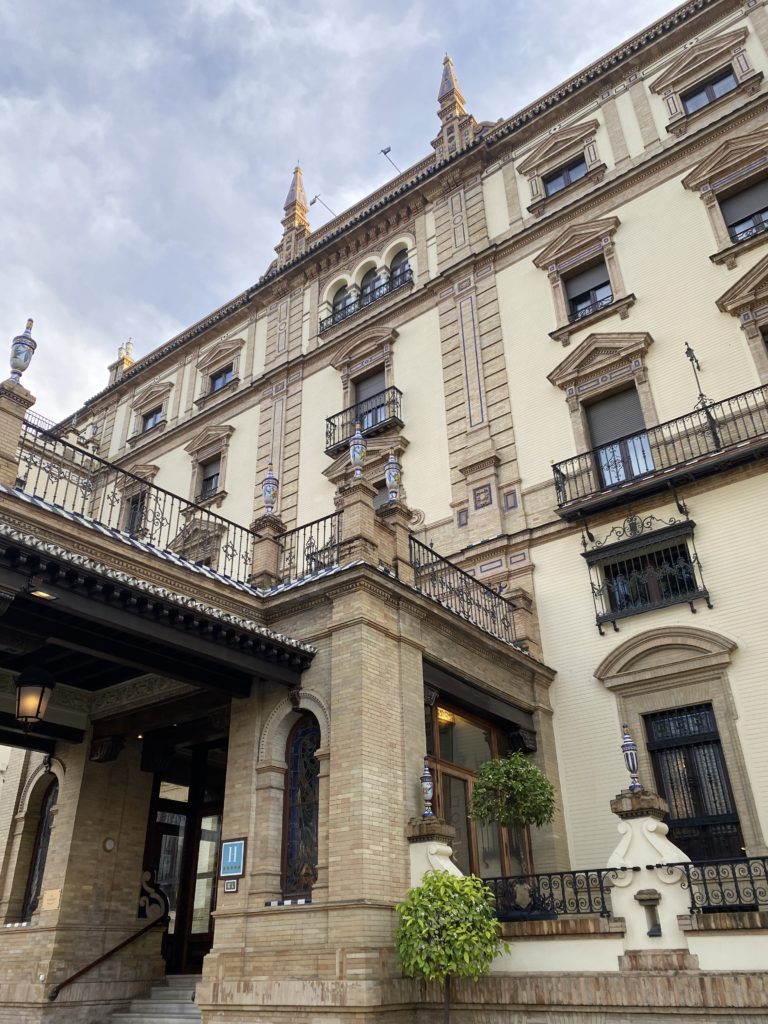
By Patrick Hunt –
One of the most beautiful and rightly famous distinctively-designed theme hotels in the world is the Alfonso III of Seville, expressly built for the Iberoamerican Exposition of 1929 under the direct sponsorship of Spain’s King Alfonso XIII in Neo-Mudéjar Style of Moorish Revival in the late 19th-early 20th c. Its spaces were planned to accommodate illustrious royalty and world leaders at the time of the exposition, also coinciding for the celebration of the royal wedding of the Infant princess Isabel with Count Juan Zamoyski taking place here that year. [1] Also, an impressive fact about these Alfonso XIII azulejos tiles is that each small tile was made first separately and glazed before being assembled together as complete ensembles in the hotel.
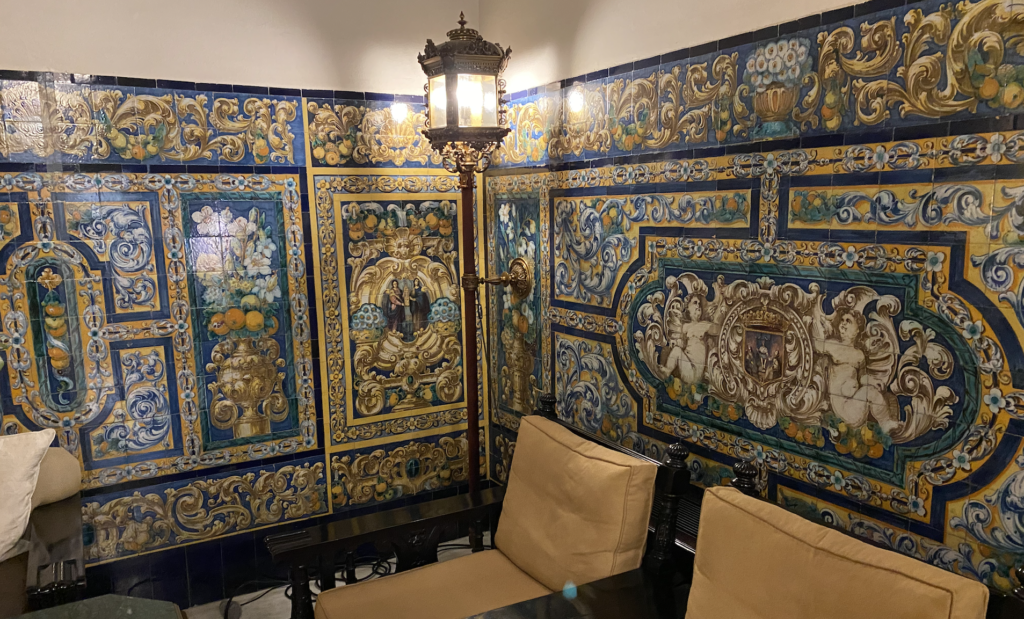
In keeping with its Moorish Revival and Mudéjar themes, the most prolific decoration of the hotel and fairly ubiquitous throughout public spaces, hallways, receptions, staircases and the Fernando Restaurant around the courtyard or patio are the thousands of azulejo ceramic tiles. Some of the azulejos ceramics can be seen as well on pillars and even on the porches and balconies with colored Spanish pedestal urns around the hotel, clearly a decorative Mudéjar theme of artistic continuity since the original early 20th c. hotel opening since Seville is so famous for its tiles and the designer-architects wanted to quote this known tradition in as many contexts as possible.
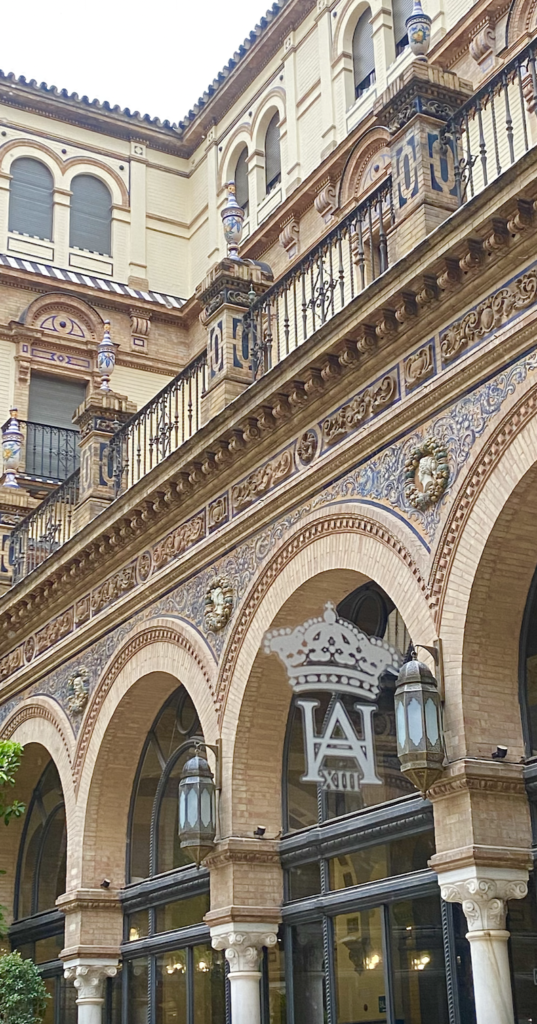
Azulejos themselves are inspired by Moorish tiles using a cobalt blue glaze following the Medieval Mudéjar traditions of Moorish zellij, colored tiles found extensively at the Alhambra in Granada of the Nasrid Dynasty from 13th-15th centuries but also in great number and variety nearby at the Royal Alcazar Palace in Seville. of course, many are familiar with the Portuguese azulejo tradition inspired by the same Mudéjar Moorish hybridity but more typically blue or blue and yellow in Portugal. [2] Azulejos are so-named from the cobalt blue color source of glaze material since Medieval in Morocco and al-Andalus, Moorish Iberia. Naturally other colors are present, and inorganic mineral sources for yellow likely from sulfur and green likely from copper as well as red likely from cinnabar become increasingly used, although the Alfonso XIII color sources are more modern.
In essence the medieval maiolica traditions around Europe are also likely inspired by Moorish tin-glazed and related ceramic tilework. While abstract geometric patterns of Moorish decorative arts give way in Christian Spain to painted imagery of nature and historical themes, the genesis is probably either Muslim craftspersons making decorations for Christians but soon imitated by Christian ceramicists for their own contexts.
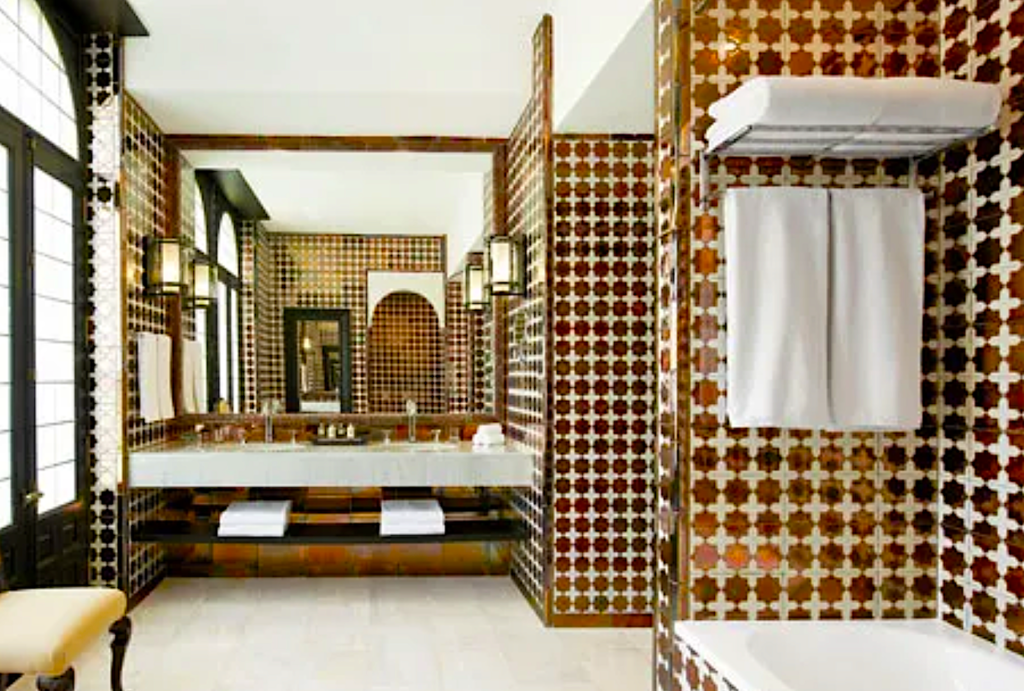
Also borrowing from Moorish ceramic zellij tiles, the tiles in some of the Alfonso XIII rooms are metallic lusterware using copper-saturated or even gold-saturated reflective glazes, [3] another medieval Mudéjar form that was originally a Muslim tradition but also used in both ceramic vessels in Alhambra Style of the 14th c. (several can be seen at the Museo Arqeológico Nacional – MAN in Madrid) and on tiles as dual ceramic contexts.
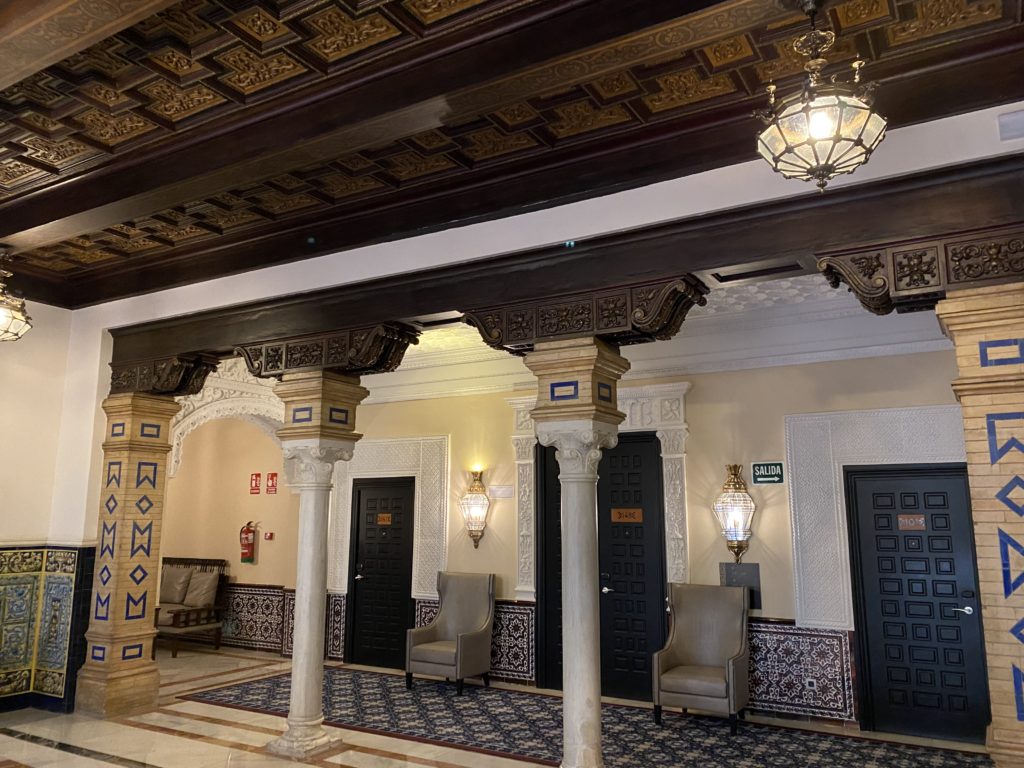
This use of colored tiles – originally zellij – was also an Islamic tradition spread across the Near East as well as the Maghreb of North African and into al-Andalus from the 8th c. onward. Yet as mentioned, most of the Alfonso XIII azulejos are in later European floral or historical depictions rather than anti-iconic (against animal or human figuration in keeping with Quranic fidelity) geometrized patterns like the typical Nasrid Granada work or at the Real Alcázar of Seville where Christianization was not yet part of the iconography especially if the craftspersons were Muslim.
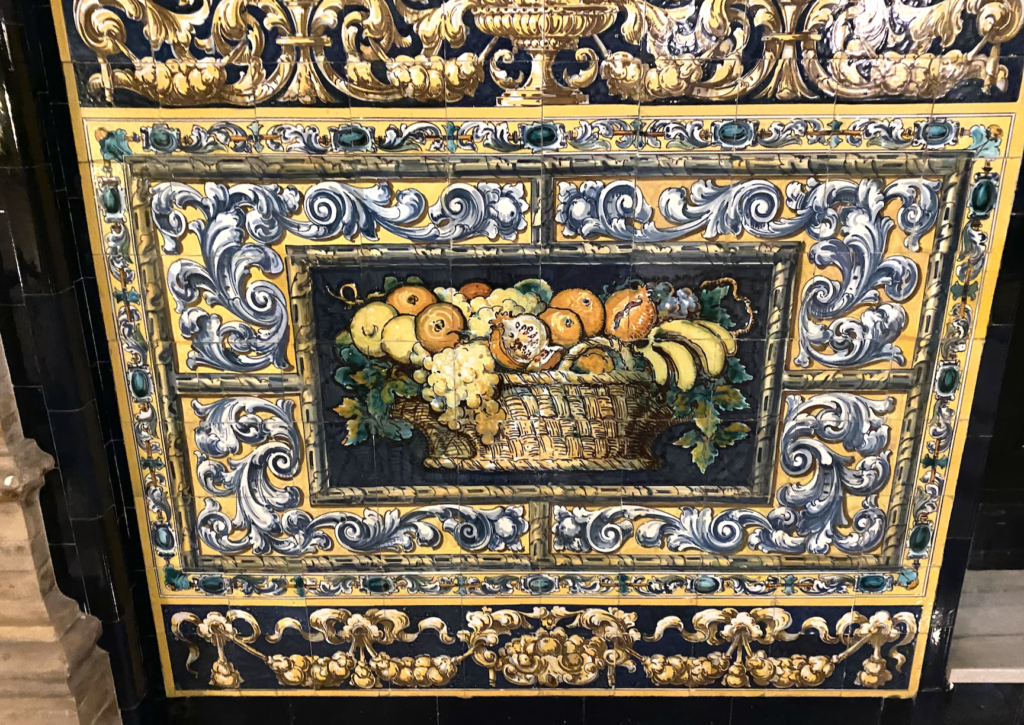
Some of the arcade decorations in the hotel public spaces reflect Spain’s royal and ecclesiastic history since Ferdinand and Isabella in 1492 as well as Moorish structures like the 13th c. Torre del Oro on the Guadalquivir River that flows through Old Seville, one of the remaining Almohad bastions on the wall. Another Alfonso XIII tile arcade alcove below shows the necessary Catholic clerical hierarchy in tandem with the new Christian royalty.
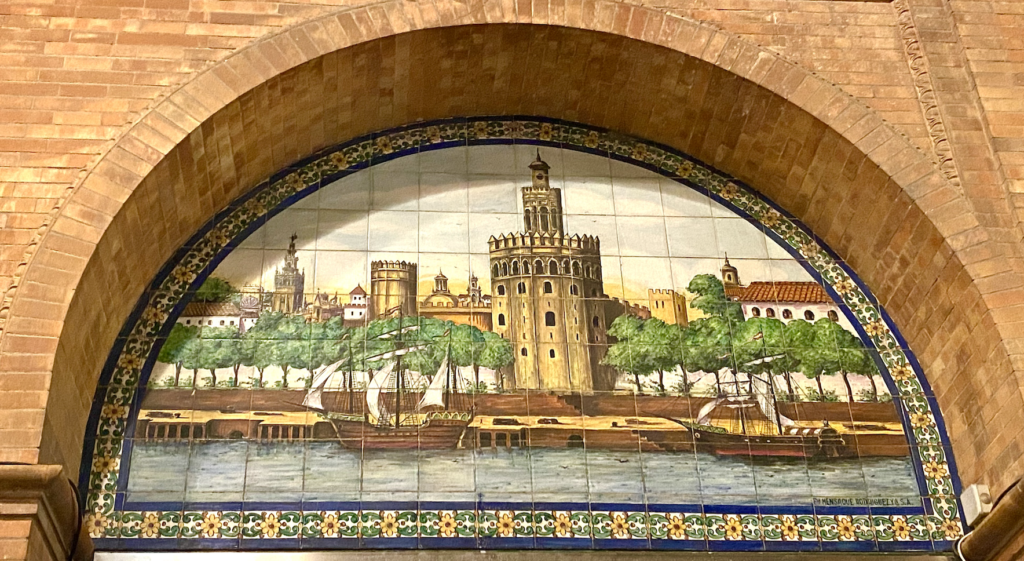
Today it is not always as easy to follow the ceramic tradition in Seville, although just across the river in the old city quarter named Triana, there are a few producers left such as Pinar Miro since Cerámica Montalván closed in 2012. [4] On the other hand, in the Jewish Quarter of Old Seville, Barrio de Santa Cruz not far from the Alcázar wall, you can also purchase handmade and handpainted modern azulejo tiles made especially for Seville tile merchants like Ceramicas Sevilla by artists collectives such as RAMA, Villaverde del Rio and individuals like J. Murrillo and Marey. Note below the crown and the supporting ecclesiastic authorities in a tile sequence.
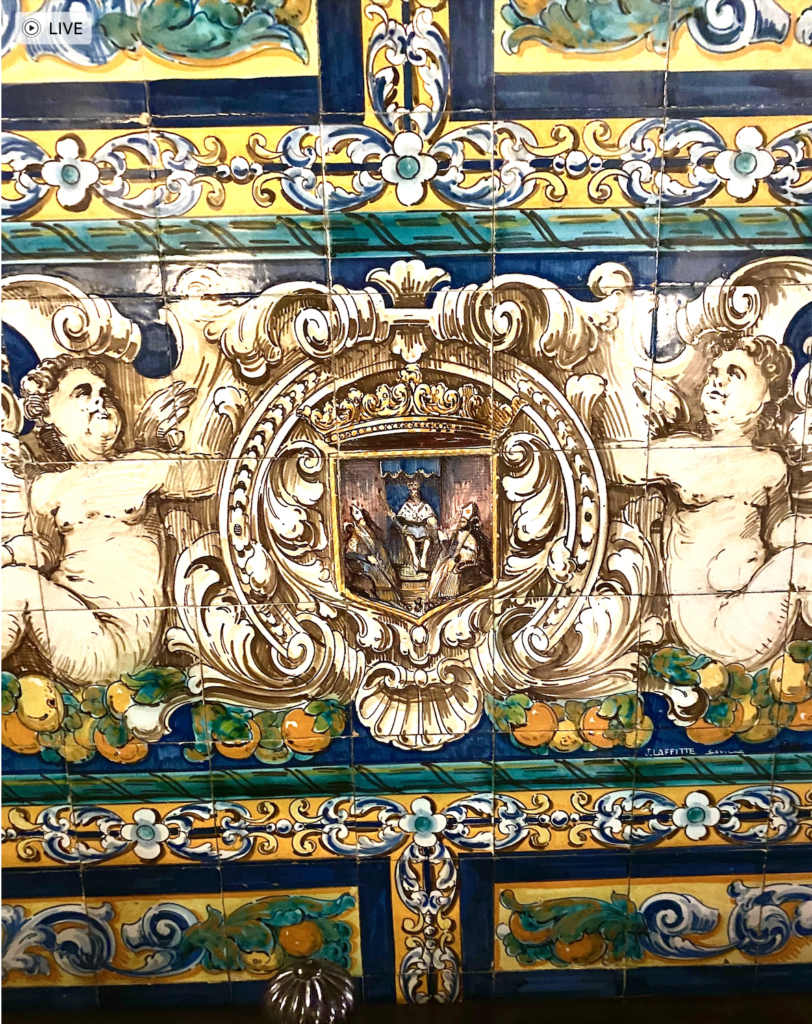
Older Mudéjar tile production in Seville, especially especially around the 17th c. at the Alcázar, was known to be from a local Triana workshop of the Valladares family and their initial firing temperatures of the silico-calcareous Guadalquivir clay could be around 900 ° C, which would be sufficient for vitrification (vidriado). [5] One of the modern ceramic high-fired traditions for azulejos production continues the use of vidriado in Spanish, which essentially means “vitrified” where the clay particles bond together in high heat above 1100 ° C, making the ceramic water impermeable because the aluminosilicate clay particles are too tightly bound to allow water penetration. Older firing was slower and at lower temperature but modern firing for commercial mass-production tends to often be faster and possibly higher. [6]
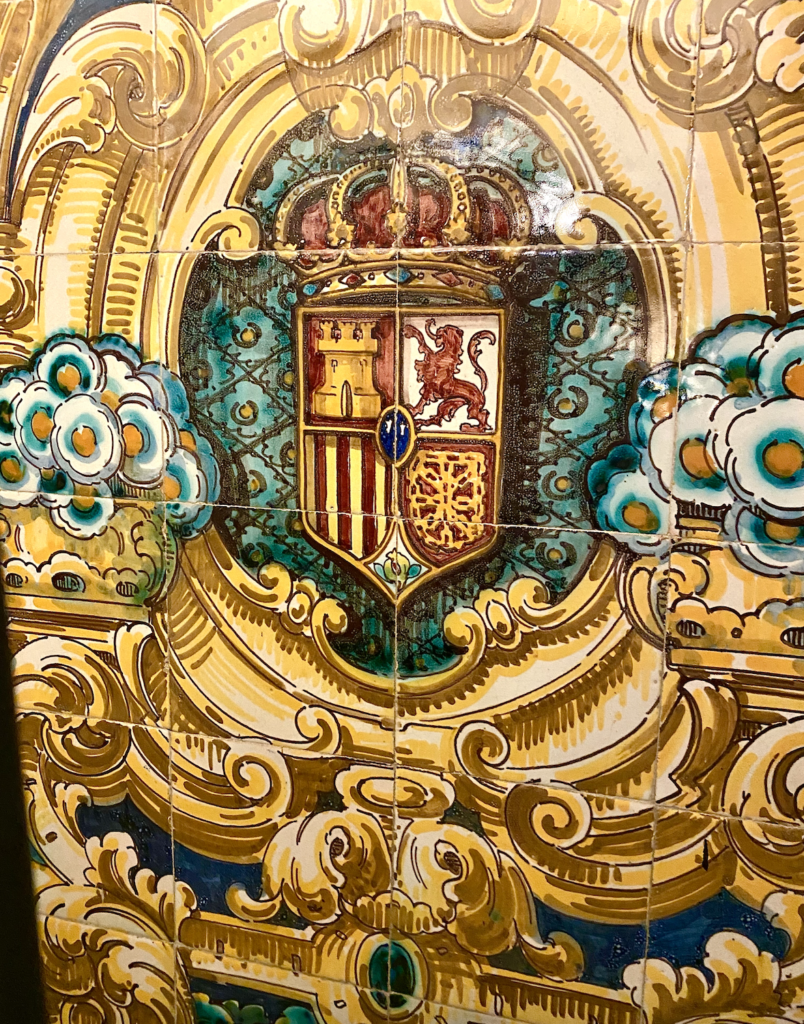
Lest anyone mistake the Alfonso XIII for anything but a royally-sponsored design statement of both power and largesse of the modern crown, the above Spanish heraldry of the royal house shows a united Spain including Navarre since the original Castile and Aragon heraldry marshaled Ferdinand of Aragon and Isabella of Castile as well as León although Ferdinand of Aragon also ruled Navarre so it was part of his heraldry even in 1492, although the Spanish Royal Catholic heraldry (1492-1504) above the Royal Throne in Segovia at Alcázar Castle does not yet show Navarre. The marshaling of the Alfonso III heraldry above shows the then-current royal arms of Alfonso XIII from upper left to lower right quartered with the triple-turreted gold castle for Castile, the red lion for León, the red and gold vertical stripes for Aragon, and Navarre’s double saltire cross (horizontal, vertical and in an X pattern) of gold chains on a red shield.
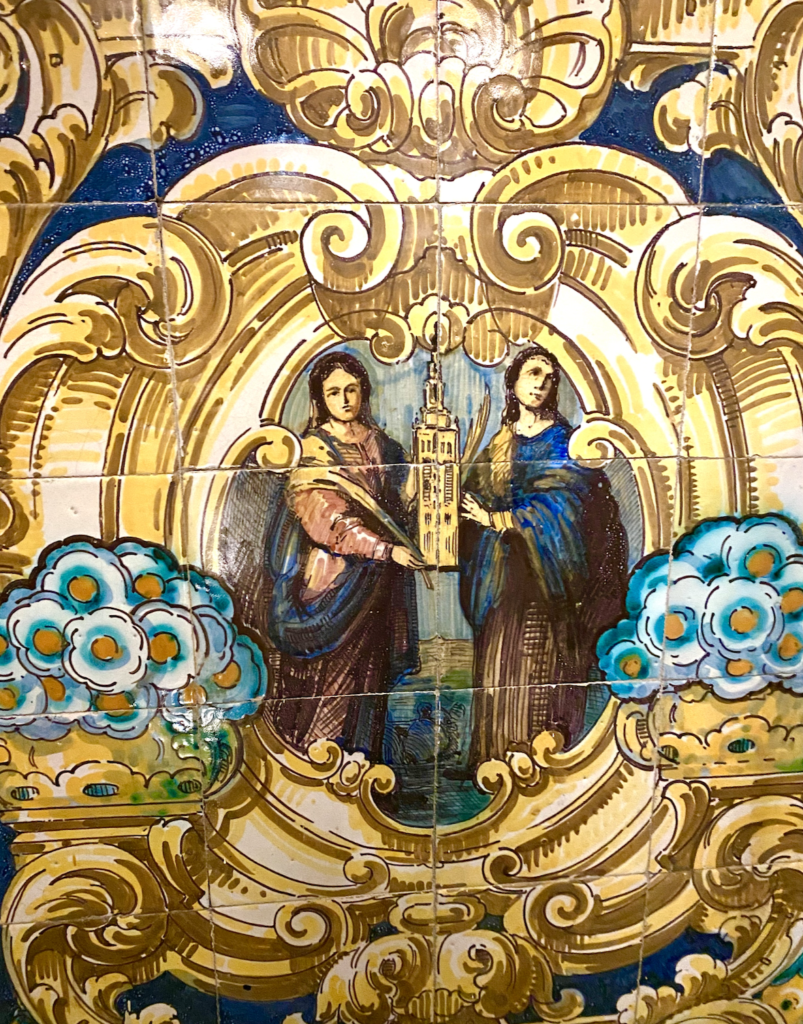
Perhaps one of the most interesting Alfonso XIII azulejo tile depictions is the above one of Seville’s patron saints, Santa Justa and Santa Rufina with their martyrs’ palm branches as they hold up the Christianized cathedral tower La Giralda which was the Mosque of Seville’s 13th c. minaret. This appears to be derived in part from the late 17th c. stained-glass window in Seville Cathedral putatively by Juan Bautista de León in the Chapel of St. Anthony, dated 1685. Murillo as well as Goya and Seville’s own Juan de Espinal have also depicted these famous martyrs often with their ceramic works. These two ancient women were martyred in Diocletian’s Persecutions around 287 CE for refusing to worship the goddess Venus apparently in old Hispalis, Roman Seville. What is most compelling is that they were potters, so the modern ceramicist of these Seville azulejos may even be highlighting and honoring the azulejos traditions of families like the Augusta and Valladares. That kind of continuity in the Alfonso XIII is exactly the kind of local civic pride one should expect in venerable Seville with such a long ceramic history of great beauty.
Notes:
[1] “1928 : Hotel Alfonso XIII Seville” Historic Hotels of the World: Then and Now , (https://www.historichotelsthenandnow.com/alfonsoxiiiseville.html)
[2] Dena Levitz. “Get to Know Portugal, Explore its Azulejo Tilework” Smithsonian Magazine Oct. 25, 2022 (https://www.smithsonianmag.com/travel/to-get-to-know-portugal-explore-its-azulejo-tilework-180980999/)
[3] Amanda Friedman, “Hotel Alfonso XIII in Seville, Spain is Renovated by Hirsch Bedner Associates” Architectural Digest, Oct. 31, 2012 (https://www.architecturaldigest.com/story/hotel-alfonso-xiii-seville-spain) Photo by Tim Beddow.
[4] Emma Love. “A Weekend on the Tiles in Seville.” Financial Times of London, April 8, 2016 (https://www.ft.com/content/e170dc10-fb38-11e5-8f41-df5bda8beb40).
[5] J. L. Perez-Rodriguez, M. D. Robador and A. Duran. “Composition and technological features of ceramics manufactured by Benito de Valladares in the seventeenth century from the Alcazar Palace in Seville, Spain”, European Physical Journal Plus 137.469 (2022)(https://link.springer.com/article/10.1140/epjp/s13360-022-02669-9)
[6] W. H. Holmes. “The Firing of Clay-based Ceramics.” Science Progress 60.237 (1972) 87-106.